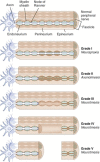Machine intelligence for nerve conduit design and production
- PMID: 32944070
- PMCID: PMC7487837
- DOI: 10.1186/s13036-020-00245-2
Machine intelligence for nerve conduit design and production
Abstract
Nerve guidance conduits (NGCs) have emerged from recent advances within tissue engineering as a promising alternative to autografts for peripheral nerve repair. NGCs are tubular structures with engineered biomaterials, which guide axonal regeneration from the injured proximal nerve to the distal stump. NGC design can synergistically combine multiple properties to enhance proliferation of stem and neuronal cells, improve nerve migration, attenuate inflammation and reduce scar tissue formation. The aim of most laboratories fabricating NGCs is the development of an automated process that incorporates patient-specific features and complex tissue blueprints (e.g. neurovascular conduit) that serve as the basis for more complicated muscular and skin grafts. One of the major limitations for tissue engineering is lack of guidance for generating tissue blueprints and the absence of streamlined manufacturing processes. With the rapid expansion of machine intelligence, high dimensional image analysis, and computational scaffold design, optimized tissue templates for 3D bioprinting (3DBP) are feasible. In this review, we examine the translational challenges to peripheral nerve regeneration and where machine intelligence can innovate bottlenecks in neural tissue engineering.
Keywords: Artificial intelligence; Bioprinting; Computer vision; Data science; Machine learning; Nerve regeneration; Tissue engineering.
© The Author(s) 2020.
Conflict of interest statement
Competing interestsThe authors declare that the research was conducted in the absence of any commercial or financial relationships that could be construed as a potential conflict of interest.
Figures


Similar articles
-
Additive manufacturing of peripheral nerve conduits - Fabrication methods, design considerations and clinical challenges.SLAS Technol. 2023 Jun;28(3):102-126. doi: 10.1016/j.slast.2023.03.006. Epub 2023 Apr 5. SLAS Technol. 2023. PMID: 37028493 Review.
-
Nerve guide conduits for peripheral nerve injury repair: A review on design, materials and fabrication methods.Acta Biomater. 2020 Apr 1;106:54-69. doi: 10.1016/j.actbio.2020.02.003. Epub 2020 Feb 8. Acta Biomater. 2020. PMID: 32044456 Review.
-
Tissue-engineered spiral nerve guidance conduit for peripheral nerve regeneration.Acta Biomater. 2018 Jun;73:302-311. doi: 10.1016/j.actbio.2018.04.046. Epub 2018 Apr 24. Acta Biomater. 2018. PMID: 29702292
-
Advances in Electrospun Nerve Guidance Conduits for Engineering Neural Regeneration.Pharmaceutics. 2022 Jan 18;14(2):219. doi: 10.3390/pharmaceutics14020219. Pharmaceutics. 2022. PMID: 35213952 Free PMC article. Review.
-
In Situ Prevascularization Strategy with Three-Dimensional Porous Conduits for Neural Tissue Engineering.ACS Appl Mater Interfaces. 2021 Nov 3;13(43):50785-50801. doi: 10.1021/acsami.1c16138. Epub 2021 Oct 19. ACS Appl Mater Interfaces. 2021. PMID: 34664947
Cited by
-
A Comparative Study of Natural Language Processing Algorithms Based on Cities Changing Diabetes Vulnerability Data.Healthcare (Basel). 2022 Jun 15;10(6):1119. doi: 10.3390/healthcare10061119. Healthcare (Basel). 2022. PMID: 35742169 Free PMC article.
-
Role of transforming growth factor-β in peripheral nerve regeneration.Neural Regen Res. 2024 Feb;19(2):380-386. doi: 10.4103/1673-5374.377588. Neural Regen Res. 2024. PMID: 37488894 Free PMC article. Review.
-
Aligned silk fibroin fiber conduits with enhanced capability for guiding peripheral nerve repair.Eur J Med Res. 2025 Aug 14;30(1):751. doi: 10.1186/s40001-025-03030-3. Eur J Med Res. 2025. PMID: 40813721 Free PMC article.
-
Electroceuticals for peripheral nerve regeneration.Biofabrication. 2022 Sep 8;14(4):10.1088/1758-5090/ac8baa. doi: 10.1088/1758-5090/ac8baa. Biofabrication. 2022. PMID: 35995036 Free PMC article. Review.
-
Artificial intelligence-assisted repair of peripheral nerve injury: a new research hotspot and associated challenges.Neural Regen Res. 2024 Mar;19(3):663-670. doi: 10.4103/1673-5374.380909. Neural Regen Res. 2024. PMID: 37721299 Free PMC article.
References
-
- Kelsey JL. Upper extremity disorders : frequency, impact, and cost. New York: Churchill Livingstone; 1997. p. ix, 77.
-
- Noble J, Munro CA, Prasad VS, Midha R. Analysis of upper and lower extremity peripheral nerve injuries in a population of patients with multiple injuries. J Trauma. 1998;45(1):116–122. - PubMed
-
- Scholz T, Krichevsky A, Sumarto A, Jaffurs D, Wirth GA, Paydar K, et al. Peripheral nerve injuries: an international survey of current treatments and future perspectives. J Reconstr Microsurg. 2009;25(6):339–344. - PubMed
-
- Sun BJ, Tijerina JD, Agbim UN, Lee GK, Nazerali RS. The quality of systematic reviews addressing peripheral nerve repair and reconstruction. J Plast Reconstr Aesthet Surg. 2019;72(3):447–456. - PubMed
Publication types
LinkOut - more resources
Full Text Sources

